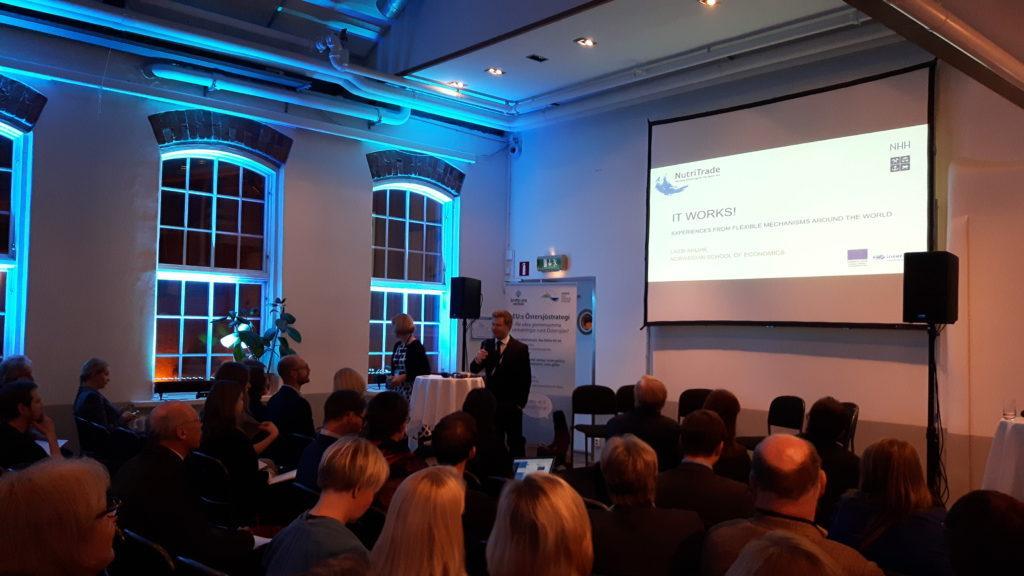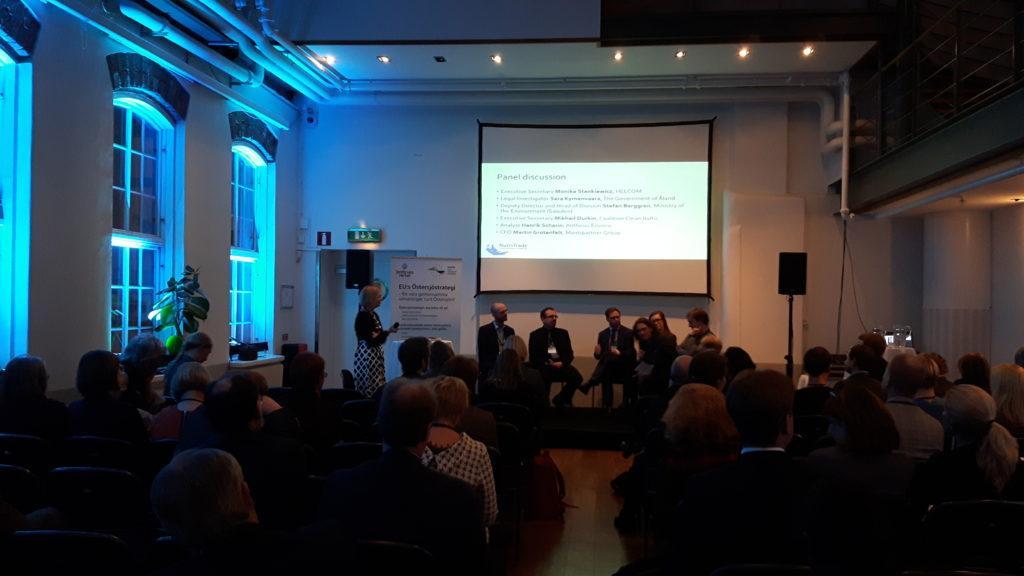On November 8, NutriTrade organized a political seminar titled “New thinking and policy design – Can Flexible Mechanisms save the Baltic Sea?” at the 7th Strategy Forum of the EUSBSR.
The event started with two presentations: First, Professor Markku Ollikainen from the University of Helsinki stressed the importance of cost-efficiency in nutrient abatement. If the allocation of nutrient reduction measures was optimized, we would reach the goals of the Baltic Sea Action Plan with only 17% of the costs estimated earlier. Our limited financial resources and the vast differences in abatement costs call for the development of new and effective abatement methods for agriculture, for speeding up nutrient abatement in wastewater treatment plants, and for the creation of mechanisms for channeling the existing willingness to pay of citizens to true actions for the Baltic Sea.
Gypsum treatment of agricultural fields holds a promise to act as a new efficient abatement measure for agriculture. With the cost of 60-70 €/kg removed phosphorus, it is a considerably cheaper measure than the existing ones. We need more of these type of measures!
Another possibility is to encourage the idea of offsetting. In greenhouse gas abatement, the concepts of carbon neutrality and zero net emissions are widely applied. Could we develop the same idea for nutrient reduction? Nutrient offsets, i.e. reductions in P or N loading to the Baltic Sea, could then be bought in compensation of loading. Offsetting would serve as a vehicle for phosphorus neutrality in wastewater treatment plants and municipalities, promote corporate social responsibility, facilitate the implementation of local solutions, and invite new institutions and people to protect the Baltic Sea.
In a second presentation, Assistant Professor Lassi Ahlvik from Norwegian School of Economics shared experiences from flexible mechanisms, notably mandatory water quality trading schemes, around the world. In particular, he presented the U.S. schemes of Long Island Sound and Great Miami River.
What can we learn from the existing schemes? According to Lassi Ahlvik, it is important to remember that trading does not replace regulation but creates demand for reductions, that complicated rules freeze the market, that the buyers want to avoid risks, and that successful schemes are based on a solid understanding of the effects of abatement measures and of retention coefficients.
If a compliance scheme is to be considered in the Baltic Sea Region, Lassi Ahlvik recommends putting it into the context of HELCOM recommendations for wastewater treatment plants or Marine Strategy Framework Directive targets. Fixed prices and a clearinghouse would facilitate trading and the use of a credit insurance pool would eliminate many risks related to unexpected events (e.g. failed practices or extreme weather). Marine models already established (BALTSEM) could be utilized in creating the tradable unit. “Instead of textbook models for trading, pragmatic solutions should be favored “, says Lassi Ahlvik.
In a panel discussion around flexible mechanisms, Monika Stankiewicz, Executive Secretary at HELCOM, encouraged the audience to keep implementing existing measures, but also start being innovative and generating new action on business and local levels. It is important to remember, however, that in water policy, the location of nutrient reduction plays a major role (contrary to greenhouse gas abatement). According to Martin Grotenfelt, CFO at Maintpartner Group, the cost-efficiency of environmental policymaking could be improved by mimicking the business community and applying relevant metrics when selecting abatement measures. In business, the determinants of success include excellence in decision making (which in the Baltic Sea context would mean understanding the ratio between input and output) and efficiency in implementation (which can be assessed with the help of key performance indicators and a rigorous follow up of them).
According to Stefan Berggren, Deputy Director and Head of Division, Ministry of the Environment, Sweden is interested in managing nutrients within the concept of circular economy. Tools are needed to improve the knowledge base and the use of financial resources. Moreover, there may be a need for new economic instruments, e.g. how to tackle internal loading, how to find profitable solutions for nutrient abatement?
Next, Mikhail Durkin, Executive Secretary at Coalition Clean Baltic, explained the link between NGO activities and the principle of cost efficiency. First of all, NGOs work with grassroot issues that bother people, bring the view of the citizens into policy processes, and oversee that public money is spent in the most effective way. This said, he welcomed the development of new economic instruments rather than measures focusing on internal load.
Sara Kymenvaara, Legal Investigator at Ålands Landskapsregering, explained that due to the Water Framework Directive’s legally binding objective of Good Status, Åland has actually discussed the idea of incorporating compensation measures into their environmental legislation. According to her, however, there are not too many compensation measures available for e.g. fish farms. A second bottleneck may be the administrative burden related to the measures.
Finally, Henrik Scharin, Analyst at Anthesis Enveco, encouraged the Baltic Sea Region to follow the US example and develop innovative mechanisms. According to him, we might be missing some low hanging fruit in nutrient reduction, if we are too stuck with existing policy instruments.


